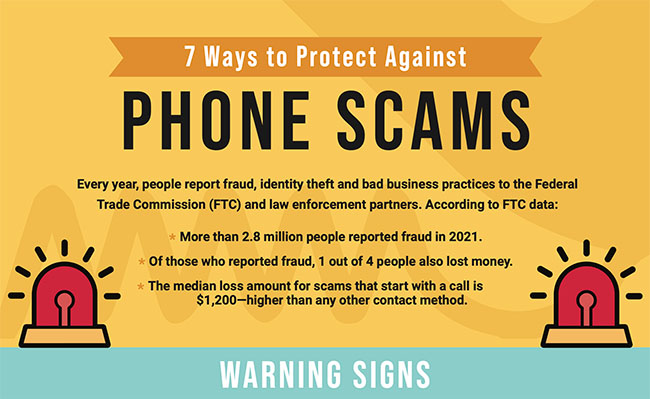
May 5, 2022 | News
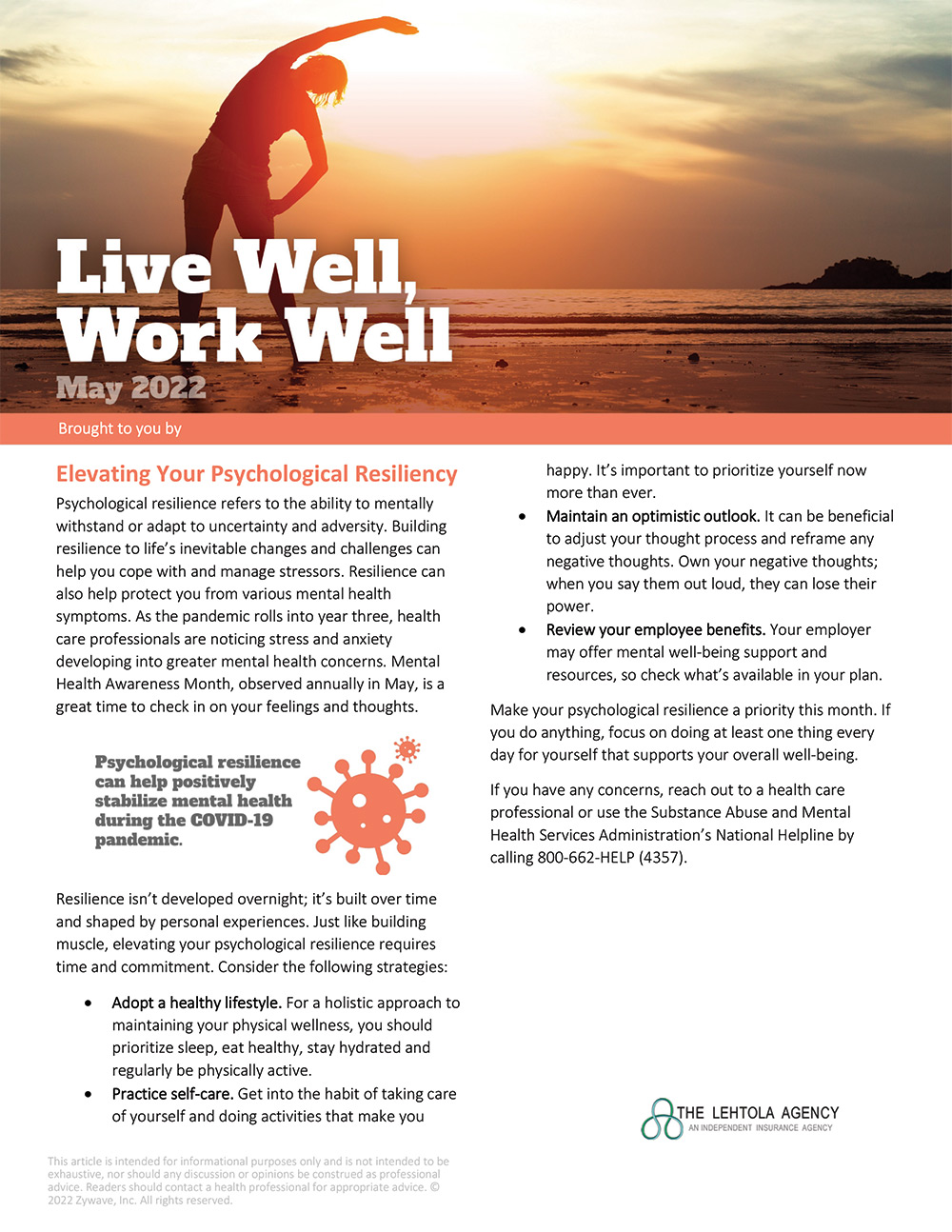
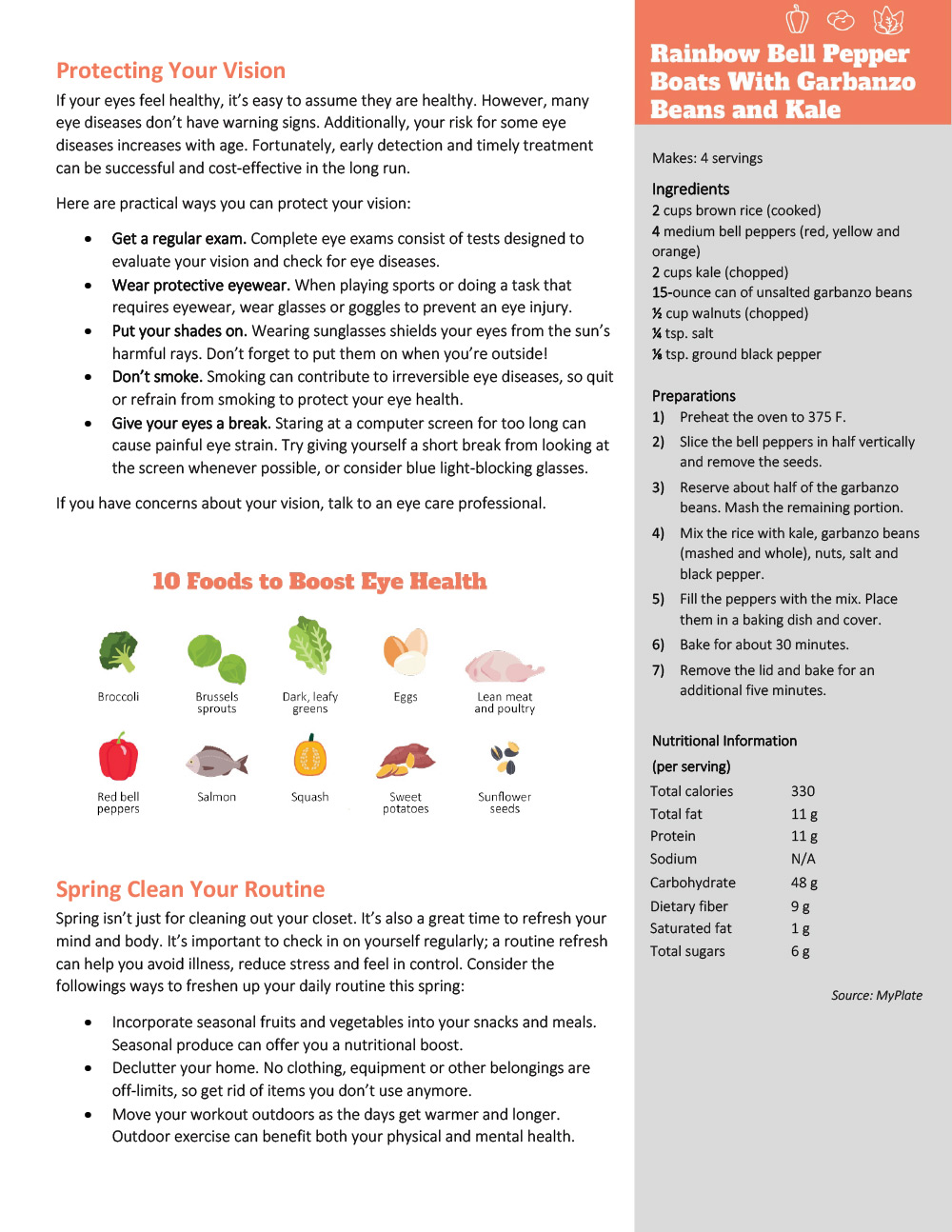
Elevating Your Psychological Resiliency
Psychological resilience refers to the ability to mentally withstand or adapt to uncertainty and adversity. Building resilience to life’s inevitable changes and challenges can help you cope with and manage stressors. Resilience can also help protect you from various mental health symptoms. As the pandemic rolls into year three, health care professionals are noticing stress and anxiety developing into greater mental health concerns. Mental Health Awareness Month, observed annually in May, is a great time to check in on your feelings and thoughts.
Psychological resilience can help positively stabilize mental health during the COVID-19 pandemic.
Resilience isn’t developed overnight; it’s built over time and shaped by personal experiences. Just like building muscle, elevating your psychological resilience requires time and commitment. Consider the following strategies:
Adopt a healthy lifestyle. For a holistic approach to maintaining your physical wellness, you should prioritize sleep, eat healthy, stay hydrated and regularly be physically active.
Practice self-care. Get into the habit of taking care of yourself and doing activities that make you happy. It’s important to prioritize yourself now more than ever.
Maintain an optimistic outlook. It can be beneficial to adjust your thought process and reframe any negative thoughts. Own your negative thoughts; when you say them out loud, they can lose their power.
Review your employee benefits. Your employer may offer mental well-being support and resources, so check what’s available in your plan.
Make your psychological resilience a priority this month. If you do anything, focus on doing at least one thing every day for yourself that supports your overall well-being.
If you have any concerns, reach out to a health care professional or use the Substance Abuse and Mental Health Services Administration’s National Helpline by calling 800-662-HELP (4357).
Protecting Your Vision
If your eyes feel healthy, it’s easy to assume they are healthy. However, many eye diseases don’t have warning signs. Additionally, your risk for some eye diseases increases with age. Fortunately, early detection and timely treatment can be successful and cost-effective in the long run.
Here are practical ways you can protect your vision:
Get a regular exam. Complete eye exams consist of tests designed to evaluate your vision and check for eye diseases.
Wear protective eyewear. When playing sports or doing a task that requires eyewear, wear glasses or goggles to prevent an eye injury.
Put your shades on. Wearing sunglasses shields your eyes from the sun’s harmful rays. Don’t forget to put them on when you’re outside!
Don’t smoke. Smoking can contribute to irreversible eye diseases, so quit or refrain from smoking to protect your eye health.
Give your eyes a break. Staring at a computer screen for too long can cause painful eye strain. Try giving yourself a short break from looking at the screen whenever possible, or consider blue light-blocking glasses.
If you have concerns about your vision, talk to an eye care professional.
10 Foods to Boost Eye Health
• Broccoli
• Brussels sprouts
• Dark, leafy greens
• Eggs
• Lean meat and poultry
• Red bell peppers
• Salmon
• Squash
• Sweet potatoes
• Sunflower seeds

Apr 25, 2022 | News
May is Motorcycle Safety Awareness Month. This event spreads safety information about motorcycles on the road. As the weather gets warmer, the number of those driving motorcycles will increase, and with that, all drivers on the road must be more aware of their surroundings to prevent accidents.
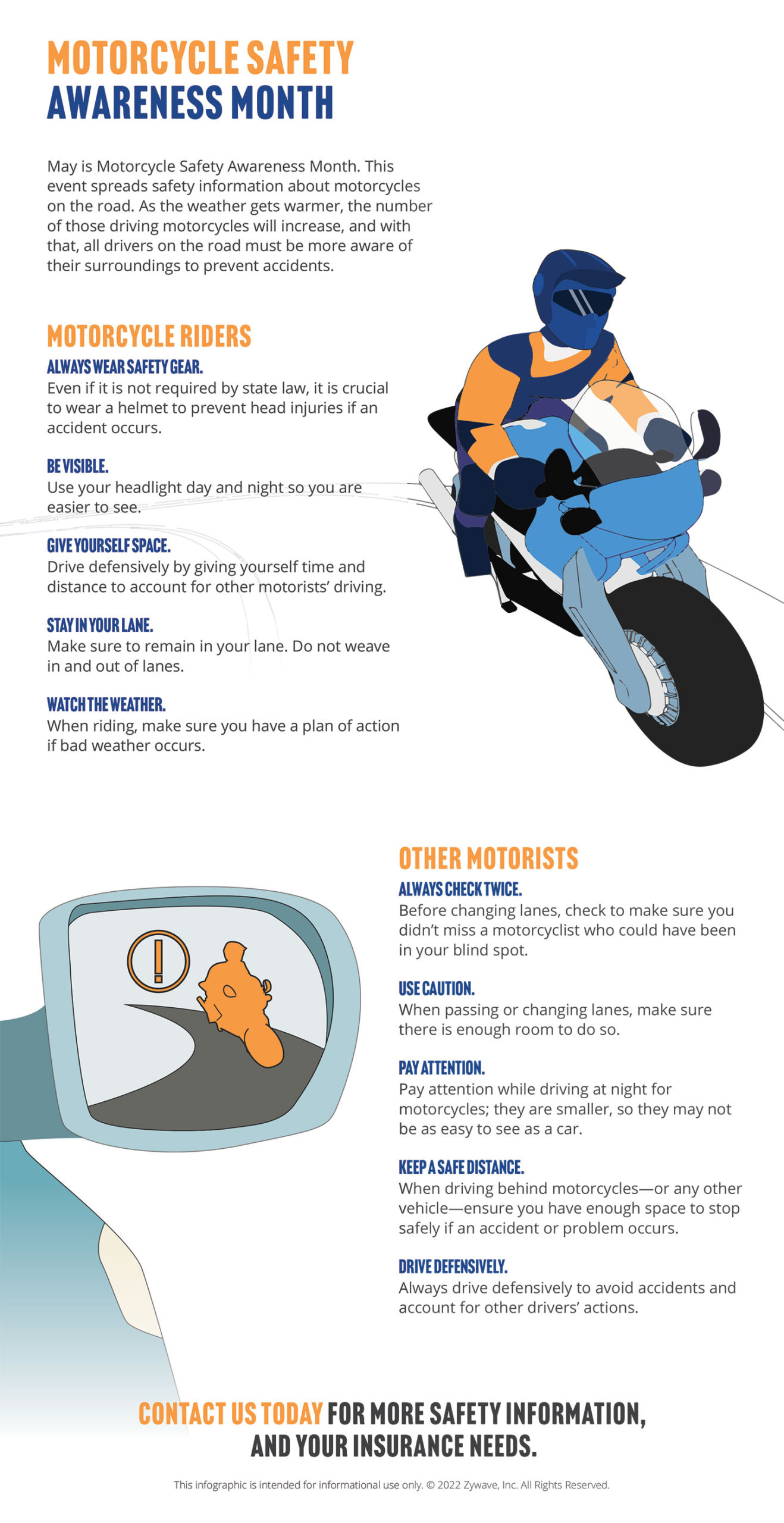
https://cms.zywave.com/sharedcontentdownload/3f1c51c1-59e9-4839-9bed-9611efc0f029
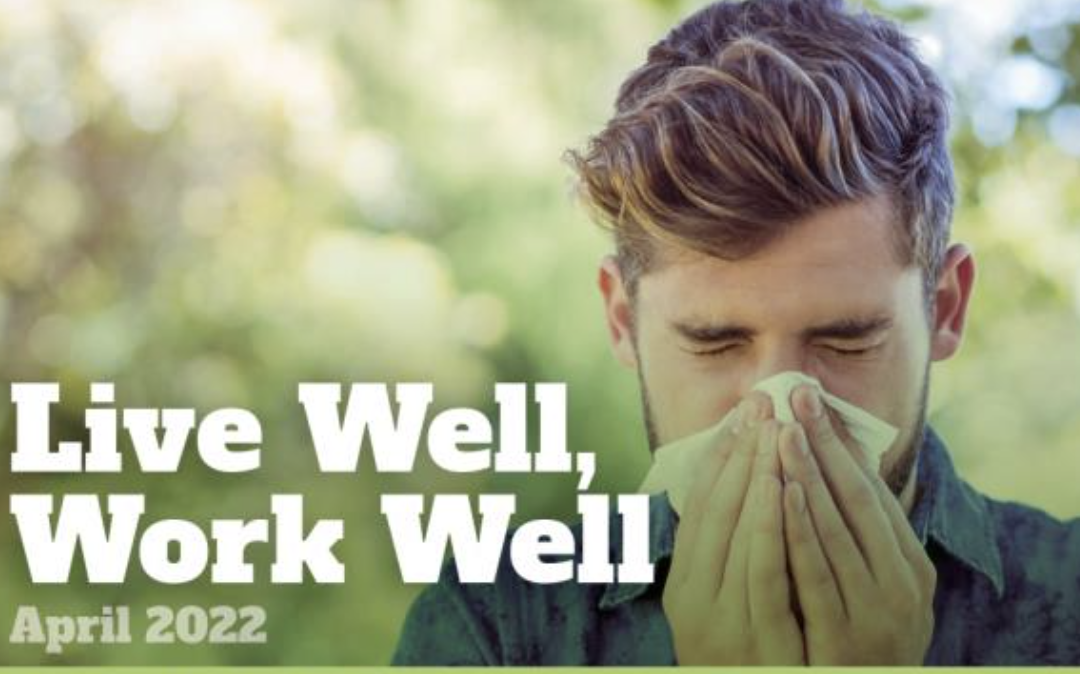
Apr 19, 2022 | News
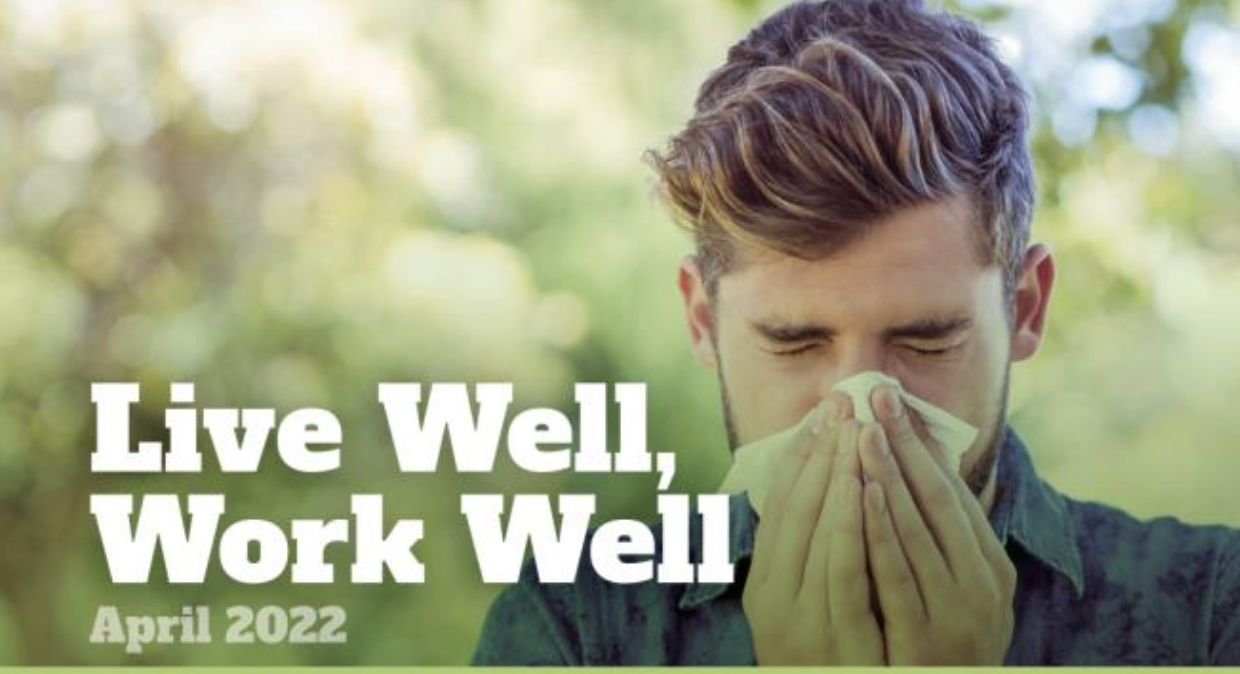
Nip Seasonal Allergies in the Bud
More than 50 million Americans suffer from allergies every year. In particular, springtime allergies are an annual nuisance for many people. As plants begin to bloom and neighbors start to cut their grass more frequently, allergy sufferers nationwide start sniffling and sneezing. What’s more, mold growth blooms both indoors and outdoors, making it almost impossible to escape allergy triggers.
Allergies are the sixth leading cause of chronic illness in the United States, according to the American College of Allergy, Asthma and Immunology.
For some, allergy symptoms may consist of sneezing a couple of times a year. But for others, seasonal allergies can cause congestion, a runny, itchy or stuffy nose, watery eyes, headaches and more for weeks or months at a time.
Fortunately, seasonal allergies only occur during certain parts of the year—usually the spring and summer. There are also natural ways to control your allergy symptoms since they are triggered by common allergens like tree pollen, grass, weeds and mold.
Alleviating Seasonal Allergies
Similar to other types of allergies, seasonal allergies develop when your body’s immune system detects and then overreacts to a foreign substance it thinks is harmful. To reduce your allergies, consider the following strategies:
- Wash your bedding every week in hot water to help keep pollen under control.
- Wash your hair before going to bed since pollen can accumulate in your hair.
- Limit the number of throw rugs to reduce dust and mold in your home.
- Wear an inexpensive painter’s mask and gloves when cleaning, vacuuming or painting to limit skin exposure and dust and chemical inhalation.
- Vacuum twice a week.
- Make sure the rugs you have are washable.
- Change air conditioning and heating air filters often.
Treatment for most allergies is available both over-the-counter and by prescription. If your allergy symptoms are severe or chronic, you may need a series of allergy shots. Contact your doctor or allergist to determine which seasonal allergy treatment option is best for you.
Mediterranean Diet Named Best Diet Again
The Mediterranean diet topped U.S. News & World Report’s best diet list for the fifth year in a row. The publication’s health experts also voted it the best diet for healthy eating, easiest diet to follow, best heart-healthy diet, best plant-based diet and best diet for diabetes. The Mediterranean diet is an eating pattern that emulates how people in the Mediterranean region have traditionally eaten, focusing on foods like whole grains and heart-healthy fats.
The Mediterranean diet may help support brain function, promote heart health and regulate blood sugar levels. Research suggests that this well-balanced eating plan can also help prevent some chronic diseases and increase longevity. Although there are no concrete rules for following the Mediterranean diet, check out the infographic below for diet guidelines.
If you have any questions about your diet, talk to your doctor.
A Balanced Mediterranean Diet
The Mediterranean diet is all about diversity, and some foods should be eaten more than others. Here are the foods you’re encouraged to eat daily, weekly and monthly:
- Eat often
- Fruits
- Vegetables
- Legumes
- Whole grains
- Heart-healthy fats
- Nuts and seeds
- Eat sometimes
- Fish and seafood
- Poultry
- Dairy
- Eat rarely
- Red meat
- Processed meat
- Sweets
Walking for a Longer Life
A new study found that if most people—particularly adults over 40—were active just 10 minutes more a day, it could save more than 110,000 American lives each year. Researchers noticed no difference in benefits based on race or sex. Not surprisingly, the study further noted that an increase of 20 or 30 minutes could lead to even more lives saved.
The study’s projections are based on an additional 10 minutes of moderate to vigorous physical activity. Such activities include bicycling, brisk walking, dancing, heavy yard work or gardening, weight training and yoga.
Health experts recommend walking outside or on a treadmill as one of the best and simplest ways to bring consistent physical activity into your life. Any movement can add up during the day, so find what works best for your schedule and lifestyle. Always remember to check with your doctor before beginning any new exercise program.
- 1 tsp. olive oil
- ½ cup sweet onion (sliced)
- 1 garlic clove (finely chopped)
- 3 small new potatoes (quartered)
- ¾ cup carrot (sliced)
- ¾ cup asparagus pieces
- ¾ cup sugar snap peas or green beans
- ½ cup radishes (quartered)
- ¼ tsp. salt
- ¼ tsp. black pepper
- ½ tsp. dried dill
- Heat the oil in a skillet. Cook the onion for two minutes, add the garlic and cook another minute.
- Stir in the potatoes and carrots. Cover and turn the heat to low. Cook until almost tender, about four minutes.
- If the vegetables start to brown, add 1-2 Tbsp. of water.
- Add the asparagus, peas, radishes, salt, black pepper and dill. Cook, stirring often, until just tender for about four minutes more.
- Serve immediately.
Nutritional Information (per serving)
- Total calories: 138
- Total fat: 1 g
- Protein: 4 g
- Sodium: 177 mg
- Carbohydrate: 29 g
- Dietary fiber: 5 g
- Saturated fat: 0 g
- Total sugars: 4 g






